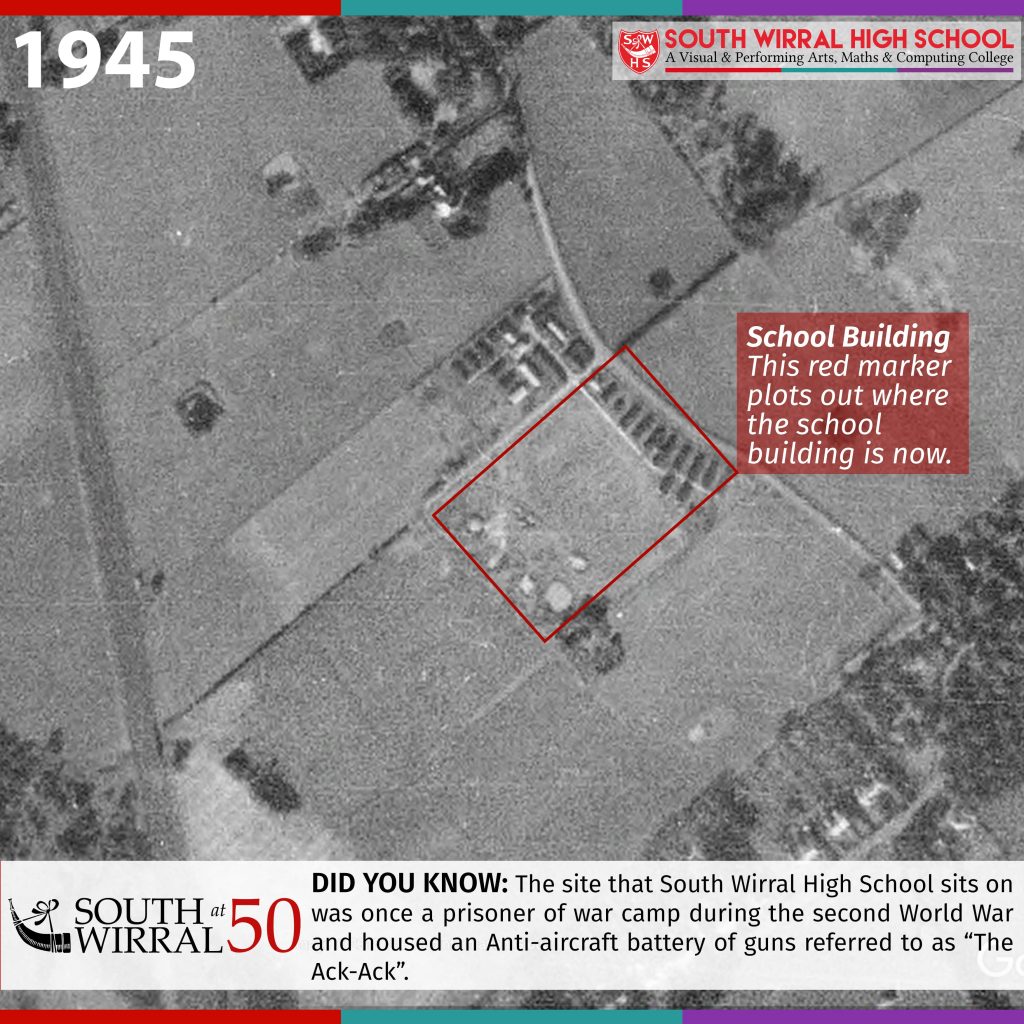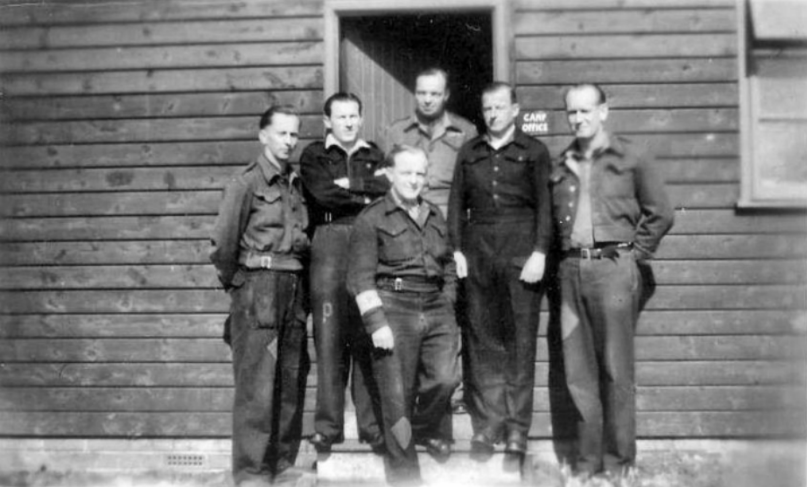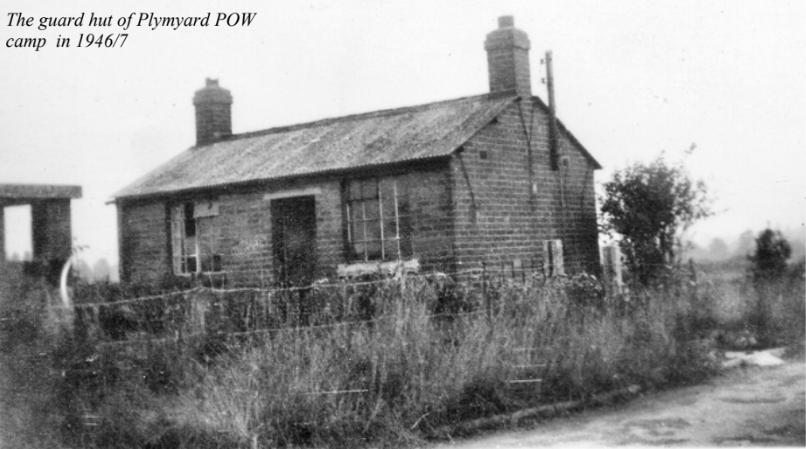The following article is taken from the Eastham Archivist Issue 12.
If you are interested in Eastham’s history or involved in family research or just want to know more about the area in which you live then please do join Eastham Archive Group.
John Amer (see photo) recalls life in Eastham during The Blitz & also the POW Camp in Plymyard Avenue
I wonder how many of the staff and pupils at the South Wirral High School are aware of the Twentieth Century history of the site on which their school is built?

I lived in Bridle Road, Eastham, from 1935 until 1953, and I clearly remember a family Sunday afternoon walk in 1940 along Plymyard Avenue, which revealed the new encampment of an Anti-Aircraft battery of large guns in their large round walled “gunpits”. The guns were referred to as “The Ack-Ack” and were located only just over half a mile from our home in Bridle Road. The site of the camp was chosen for its good defensive position under the flight-path of the German “Luftwaffe” (Air Force) aircraft heading to bomb the Cammel-Laird shipbuilding yards at Birkenhead, the docks at Birkenhead, Wallasey and Liverpool, and the assembly area in the Mersey estuary of the transatlantic convoys.
The air raids “Blitz” (the collective term for the period of intensive bombing) on Merseyside and the Wirral, which commenced in July 1940 continued for a nine months period until May 1941. During the first five months of 1941 we, as a family continued to sleep on the floor downstairs in the front room; I clearly remember, when an air raid was on, hearing the very loud explosions and seeing the accompanying flashes of the antiaircraft guns in Plymyard Avenue appearing above the tops of the blackout curtains – before moving into the back garden to the Anderson shelter.
In the daytime following such air raids I developed an activity, together with the boy of the same age next door, of going round the local roads looking to collect the “shrapnel”, i.e. the jagged metal remains of the anti-aircraft shells, which had been fired by the “Ack-Ack” in Plymyard Avenue at the invading German aircraft passing overhead. That which goes up must also come down! I still possess some of my shrapnel collection.

Towards the end of the Second World War, as the military action in Western Europe moved increasingly further eastwards, and the threat of German air raids receded, the anti-aircraft guns in Plymyard Avenue were removed and the Camp given over to the housing of Italian Prisoners of War (PoWs). Plymyard Avenue soon became an attraction to the inhabitants of the village and the promenading along Plymyard Avenue to gaze at the incarcerated Italians a regular feature of their Sunday afternoons. When news reached the local populace that the Italians had been replaced by German PoWs – by July 1945 all Italian PoWs had been repatriated – the Camp became an even greater attraction to Sunday afternoon strollers desirous of gazing upon the now caged erstwhile enemies.

It is interesting to note that in September 1946 there were some 402,200 German PoWs in Britain, 84.9% of whom (all non-officers) were engaged in working, largely in agricultural or other forms of labour.
Initially, German PoWs were not allowed out of Plymyard Camp, except when they were loaded on to lorries and sent out as “work details” for employment in the fields to assist farmers in the area; they were certainly not allowed out of the Camp as individuals. Their identity could be immediately recognised by their PoW uniforms which consisted of British battle dresses dyed a chocolate brown colour and by the large yellow diamond-shaped patches let into the trousers and back of the jackets. The British Government had ruled that there was to be no fraternisation with German PoWs if members of the public did happen to come into contact with them.
One sunny Saturday afternoon in early Autumn 1946 I was walking past St Mary’s Parish Church when I spotted two German PoWs standing at a distance to watch a wedding party being photographed outside the Lychgate. Equipped with my first rudimentary German from my recent lessons at school, albeit blissfully unaware of the “no fraternisation” rule I approached the two PoWs, greeted them in German and enquired after their health, introducing my name to them and enquiring after their names. The taller of the two was Otto Foerstel from Thuringia in eastern Germany, and the name of the shorter of the two was Ernst Eckart from Bavaria. They were both former Senior Non-Commissioned Officers in the German Forces and had been allowed out of Camp because they were “Trusted Ones” and both were part of the “Trusted Team” of former NCOs who manned the Plymyard Camp guardroom. The Camp Commandant was a British Army Warrant Officer and there were a handful of British soldiers acting as Camp Guards. However, as I was to discover, there was a fairly easy-going regime and in no way comparable to the images of German camps for British PoWs as depicted in films.

Initially there were a number of restrictions placed on German PoWs, even after they were allowed more freedom to go out from the Camp. For example, until June 1947 they were not allowed to have British Sterling currency – they had their own special camp money only valid within the camp itself. They were not allowed to enter shops or travel on buses, nor initially were they allowed to enter British homes. However, on Sunday, 15th December, 1946, it was announced on the BBC that the British Government had lifted the ban on fraternisation with German PoWs, and even encouraged British families, if there were German PoWs in their neighbourhoods and they felt able to do so to invite them into their homes at Christmas. Shortly after this announcement I accompanied my father to Plymyard Camp to request that Otto and Ernst be allowed to visit us at Christmas. Up to this point I had continued regular contact with them, visiting them in the guardroom at the entrance to Plymyard Camp when they were on duty, and can clearly remember that distinctive smell of the coke-fired stove, which provided the only heating.
Once the “no fraternisation” rule was lifted and permission granted to enter British homes both Otto and Ernst became very welcome regular visitors to our home in Bridle Road. Otto and Ernst were repatriated to Germany at the end of 1947 or early 1948, and we continued to keep in touch by correspondence, certainly with Ernst until his death. However, Otto had returned to his home in Thuringia located in the Russian Zone of Occupation, and his correspondence with us in England was very short-lived. I imagine it was treated with suspicion by the Communists and he may have suffered for it, or decided that it was not wise to continue. It was gratifying to read what Ernst wrote to me in February 1952: “I often have to think of our first meeting and on the lovely hours when I was able to sit with you all by the open fireplace. How especially lovely was that first Christmas 1946 with you all, when I was able again for the first time to feel at ease, as if I was at home. That was really very nice of your parents.”

In August 1954, just days after I had arrived home on Leave from the British Army of the Rhine, Ernst arrived from Bavaria by car with his wife and son to visit us in Bridle Road. In May of the following year I was able to spend some days of Leave with them in Bavaria. Further visits to Ernst in Bavaria followed in August 1967 and again in August 1973 – in the latter case with my wife and daughters. Doubtless other similar international friendships had their origins in the Plymyard Avenue Camp.
Another Camp Memory I well remember Plymyard Ave when it was in its original status. It had lift gates at each end as it was a strictly private road. Slack’s farm was about half-way down,( wonder how Susan Slack is these days?) the army had a big piece of his property as an antiaircraft post during WW2.After the Blitz was over the site was de-commissioned, but after D-Day it was converted into a POW camp. I remember being with my pals , Albert Roscoe, Gem Southwood, and Ken Spillsbury going down the Rake and we came upon about 200 German SS troops, who had de-trained at Hooton station marching and singing, heavily guarded on their way to the Plymyard camp for internment. Eastham was a crazy place during WW2, never a dull moment!
Taken from an Internet post by Colin Ward
